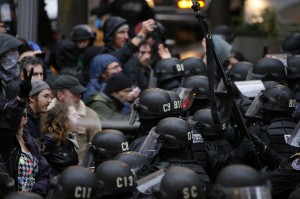
To do great writing, read great writing. Here’s the great writing I’ve been reading this week:
I don’t write about local news, but I read it. This week I’ve been closely monitoring the Occupy Portland decampment and subsequent protests, which have included a walkout of Portland State University students, several marches, and yesterday’s N17 occupation of several downtown Portland branches of national banks.
I’ve read a lot, in the Oregonian, the Portland Mercury, online, on Twitter and Facebook.
Nothing I’ve read comes close to having the impact of a single photograph of the confrontation between Occupy Portland protesters and the Portland Police Department taken on Nov. 17.
I’m sharing a copy here so readers see what I’m talking about, but to really appreciate the impact, see the full image on the OregonLive.com website. Long-time Oregonian photographer Randy Rasmussen captured the split second a Portland police officer pepper sprayed a young woman directly in the face. Her eyes are closed, her mouth open, either in suprise or because she’s shouting something. It’s at once animated and chilling – the rag-tag protesters on one side and on the other, a sea of black helmeted cops that look like they could be from Star Wars.
The photo has gone viral, as the Oregonian‘s Noelle Crombie notes in this story. The Atlantic Wire says the photo “may become the defining image of this week of Occupy unrest.” According to the Atlantic:
But in the confusion and impending darkness on Thursday evening, Rasmussen was shooting blind. He said he didn’t see the photo until his editor did, as they went through the day’s frames together that night.
Aside from being a striking embodiment of the old “picture is worth 1,000 words” saying, what does this have to do with writing?
Remember what Rasmussen said – he didn’t know what he had until later. He was just trying to capture as much information as he could a the time.
Think of that when you’re researching a story, or conducting an interview. Gather as much information as possible without regard for how you’re going to use it. There will always be time later to shift through the material: who knows, maybe you too will uncover something you didn’t realize was there.
I love what you’ve written here Michelle. I think at some point all of us have stared at a blank page, poised to write when we find the so-called inspiration–or hit on the defining image.
But it doesn’t work that way. Not in copywriting, journalism, fiction, poetry, academic writing–or photography, graphic design or any other “creative” discipline I can think of. The masters are unafraid to dive in, gathering whatever might be useful in their nets on the way down. The discipline comes later. The mess and excess are part of the process.
The biggest mistake we can make is decide, long before a piece comes together, what does and doesn’t belong. Imagine if Randy were shooting only what caught his eye!
Amen. If you’re staring at a blank page not sure what to write, you haven’t done enough research or reporting. Do enough and the story starts pouring out of your skin, like sweat.
And there’s nothing like a deadline for inspiration.
Michelle
Very wise writing advice. And, like you, I’ve been watching the coverage of the occupy movement very closely — both as a study in journalism (what is and isn’t being covered; and how the various elements of the story are being covered) and because I think we are witnessing the birth of a very important social movement: one we will be talking about for many years to come.
That’s a fascinating image and I enjoyed how you tied it into the journalism craft. You might also be interested in a print journalism initiative happening with Occupy Boston: http://bostinnovation.com/2011/11/18/read-all-about-it-the-boston-occupier-the-newspaper-for-the-occupy-boston-movement/